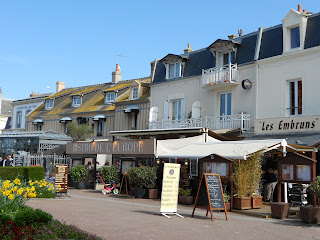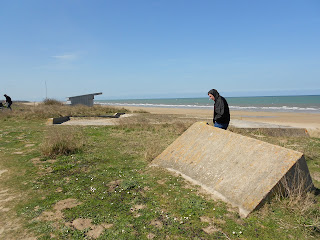My dad came to visit Paris about a month ago, and because he's been to Paris several times before we decided to venture outside the city, and had a little field trip to the D-Day beaches in Normandy.
It's a bit hard to get around in this area of the country as it's somewhat rural and the train system does not extend to the coast. After some research I figured out a way to get us there, but we were only able to go to one of the beaches, Juno. For those who don't know, these beaches are where the British, American, and Canadian troops landed on the French coast on June 6th, 1944, to begin the liberation of Europe.
Each beach - distinguished by the troops that landed there - had a code name, and Juno beach was where the Canadian troops came. Omaha beach is probably the most well-known in the US, partially because it was an American landing site and partially because that's where the hardest fighting was. Unfortunately it's also the farthest beach from any towns, and hardest to get to on foot - not to mention that when I was there 12ish years ago we weren't able to go onto the beach because there were too many wild boars!
Anyway, the Juno beach site is in Courseulles-sur-Mer, a tiny fishing/tourist town. It has a distinct medieval feel, I guess because it has never really grown much since its height as a vacation and fishing spot in the late 1800's.
All the sites to do with the battle are very well done, with nice memorials and flowers, and the museum is also very good.
This tank sits in the central town square:
Units (is that the right word?) have come back to put memorial plaques on the tank, many in French, apparently from Quebec.
Not far away is this German anti-tank gun - you can see where it was damaged by the tank fire.
There are several of these types of monuments, both for the WWII battles and a couple for WWI losses from the town.
The museum is run by a mix of French and Canadian people; it's small but well-done and has good information. As someone who is no expert on WWII at all I found it really interesting.
This is the museum, just away from the actual beach.
It's supposed to be designed in a modern version of the Canadian maple leaf.
So, for the history: this invasion of German-occupied France was an extremely difficult and delicate operation - the tides, the weather, the locations all had to be monitored carefully because everything depended on secrecy and taking the Germans by surprise. The German troops were set up in dozens of bunkers along the coastline, many of which survive in various states of burial.
We could go inside two of them (one rather crawling).
There's my dad to show how small the space is!
The Canadian troops landed on the beaches and had to fight their way through the German lines. The fighting here are Juno beach was the second toughest, after Omaha, and there was a large number of casualties.
It's hard to imagine this serene, almost desolate beach as being a bloody, militarized battle zone.
I have it on good authority (from my father) that these things were put out in the water to slow down the ships that were transporting the soldiers and equipment, so that they landed in such a place to be in the line of cannon and gunfire as they were leaving the ships.
The invasion was carefully planned for many months before it actually took place, spearheaded by the heads of state and military in the US, Great Britain, and Canada, and with help from General de Gaulle, who was at that point still in London after fleeing when the Germans took northern France. They also had to cooperate with the Resistance in France, of course, to let them know the Allied army was coming. It was extremely difficult to get messages to and from the Resistance, but it was generally done in codes via radio transmissions.
This memorial shows how they let the Resistance know when the Allies would arrive: Paul Verlaine, a French poet and member of the Resistance wrote this poem. The first stanza was broadcast on the night of June 2nd, to let them know the Allies were on their way, and the second stanza was broadcast the night of June 5th, to say the landing would happen the next day.
(The long sobs of autumn violins/wound my heart with a monotonous languor)
The Allies successfully broke through the German lines after about a day and a half of heavy fighting and many continued on through Normandy and the northern French countryside, onto Paris and the surrounding area.
General de Gaulle, the head of the Resistance and "Free France," landed at Juno beach on June 14th. This monument, a little way down the beach from the museum, commemorates his landing with the Cross of Lorraine, which was the official symbol of the Resistance. (Interestingly, the cross is a reference to Joan of Arc, who was from Lorraine and who is considered to have saved France during the Hundred Years War with England - just as the Resistance believed it would save France from the Germans.)
So everyone knows that I love history and am a huge nerd - but I don't really like military history for the most part, and WWII is way too modern for my tastes in general. Despite that, though, I found this site absolutely fascinating and also very moving. It's easy to see how much it means to both the surviving troops and the people of France. The D-Day invasion was really the beginning of the end of WWII, and it was a bold, brave move by the Allied forces. It was not entirely successful (although obviously it was in the long run!) but I think most historians today would say that even more than the accomplishment of breaking through Hitler's "Atlantic wall" it was the symbolism of D-Day that was important: people could see, for the first time since the fall of France, that Hitler's takeover of Europe could be challenged, and halted. The Germans had seemed unstoppable up to this point but here the Allies broke through their lines and began the long trek to liberate France, and Europe.
A final funny little point: in 1066 England was conquered by William of Normandy, a Frenchman. It was one of only two (three if you count a very short period of Viking rule) times in history that the British Isles were invaded successfully, and "The Conquest" has remained in the British national consciousness ever since. William left to invade England from these beaches, which were part of his duchy, and it was here that the British troops came back to liberate France almost 900 years later. A couple of signs at Juno beach remind people of that fact, and I think it's funny that the 11th century moment is seen as kind of an opposite-prelude to the liberation.
In my opinion it could also be the turning point of 1000 years of enmity between the French and English. :)
Tuesday, May 1, 2012
Subscribe to:
Post Comments (Atom)





















2 comments:
Angie and I had a wonderful time on this excursion to Normandy. She planned a great outing--- we did metro, to the train, to a local bus, and then reverse to get back. It was a moving place and the museum was excellent in its depiction of how Canada changed from the 1920's to the 1940's, mostly because of the war. It was windy and cold when on the beach, but when we were sheltered from the wind, it was very nice out. I had a wonderful day, and for that matter, a wonderful week with my darling daughter. We went out to nice restaurants to eat each night (lunch at Normandy was a nice place as we got back too late for dinner) and we saw lots of churches and museums during my visit. I also did stuff on my own as she was working--- went to Louvre and did other wondering around, riding the metro, etc. and generally had a very nice time with Angie in her adopted country.
War is a fascinating subject. Despite the dubious morality of using violence to achieve personal or political aims. It remains that conflict has been used to do just that throughout recorded history.
Your article is very well done, a good read.
Post a Comment